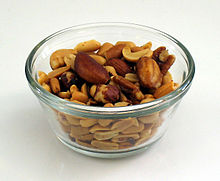- Granular convection
-
Granular convection is a phenomenon where granular material subjected to shaking or vibration will exhibit circulation patterns similar to types of fluid convection.[1] It is sometimes described as the Brazil nut effect when the largest particles end up on the surface of a granular material containing a mixture of variously sized objects; this derives from the example of a typical container of mixed nuts, where the largest will be Brazil nuts. The phenomenon is also known as the muesli effect since it is seen in packets of breakfast cereal containing particles of different sizes but similar density, such as muesli mix.
Under experimental conditions, granular convection of variously sized particles has been observed forming convection cells similar to fluid motion.[2][3] The convection of granular flows is becoming a well-understood phenomenon.[4]
Contents
Explanation
It may be counter-intuitive to find that the largest and (presumably) heaviest particles rise to the top, but there are several possible explanations:
- The center of mass of the whole system (containing the mixed nuts) in an arbitrary state is not optimal (because of the space close to the Brazil nuts); it has the tendency to be higher due to gravity. When the nuts are shaken, gravity will make sure the center of mass of the system moves down and this can only be done by moving the Brazil nuts up. Gravity will also make sure they stay up.
- Including the effects of air in spaces between particles, larger particles may become buoyant or sink. Smaller particles can fall into the spaces underneath a larger particle after each shake. Over time, the larger particle rises in the mixture.
(According to Heinrich Jaeger,[5] "[this] explanation for size separation might work in situations in which there is no granular convection, for example for containers with completely frictionless side walls or deep below the surface of tall containers (where convection is strongly suppressed). On the other hand, when friction with the side walls or other mechanisms set up a convection roll pattern inside the vibrated container, we found that the convective motion immediately takes over as the dominant mechanism for size separation."[6])
- When shaken, the particles move in vibration-induced convection flow: individual particles move up through the middle, across the surface, and down the sides. If a large particle is involved, it will be moved up to the top by convection flow. Once at the top, the large particle will stay there because the convection currents are too narrow to sweep it down along the wall.
- The phenomenon is related to Parrondo's paradox inasmuch as the Brazil nuts move to the top of the mixed nuts against the gravitational gradient when subjected to random shaking.[7]
Granular convection has been probed by the use of MRI imaging [8] where convection rolls similar to those in fluids (Bénard cells) can be visualized.
Applications
Manufacturing
The effect is of serious interest for some manufacturing operations; once a heterogeneous mixture of granular materials has been produced, it is usually undesirable for the different particle types to segregate. Several factors determine the severity of the Brazil nut effect, including the sizes and densities of the particles, the pressure of any gas between the particles, and the shape of the container. A rectangular box (such as a box of breakfast cereal) or cylinder (such as a can of nuts) works well to counter the effect,[citation needed] while a cone-shaped container results in what is known as the reverse Brazil nut effect.[citation needed]
Astronomy
In astronomy, it is also seen in some low density, or rubble pile asteroids, for example the asteroid 25143 Itokawa.[9]
Geology
In geology, this phenomenon is one of the causes of inverse grading which can be observed in many situations including soil liquefaction during earthquakes or mudslides.
See also
References
- ^ http://jfi.uchicago.edu/granular/convection.html
- ^ Frank Rietz and Ralf Stannarius,On the brink of jamming: Granular convection in densely filled containers, Phys. Rev. Lett. 100, 078002 (2008).
- ^ Baffling Patterns Form in Scientific Sandbox, Wired, Brandon Keim, October 28, 2009, http://www.wired.com/wiredscience/2009/10/bead-cloud-mystery/#ixzz0xbmvgKP1
- ^ Grains of Sand Reveal Possible Fifth State of Matter, Wired, Brandon Keim, June 24, 2009, http://www.wired.com/wiredscience/2009/06/sandgrains/#ixzz0xboW3KAI
- ^ http://jfi.uchicago.edu/~jaeger/hmj/HMJ_short_bio.pdf
- ^ "Sidney Nagel and Heinrich Jaeger Q&A". Pbs.org. http://www.pbs.org/safarchive/3_ask/archive/qna/3294_sand.html. Retrieved 2010-09-27.
- ^ Abbott, Derek (2009). "Developments in Parrondo's Paradox". Applications of Nonlinear Dynamics. Springer. pp. 307–321. ISBN 978-3-540-85631-3.
- ^ "Granular Convection Observed by Magnetic Resonance Imaging - Ehrichs et al. 267 (5204): 1632 - Science". Sciencemag.org. doi:10.1126/science.267.5204.1632. http://www.sciencemag.org/cgi/content/short/267/5204/1632. Retrieved 2010-09-27.
- ^ Smooth Sections of Asteroid Itokawa NASA Astronomy Picture of the Day 22 April 2007.
External links
- Beads in a Box on YouTube
- Convection rolls in almost densely filled rotating containers, University of Magdeburg
- PhysicsWeb: The Brazil Nut Effect
- Yan, X.; Q. Shi, M. Hou, K. Lu, C. K. Chan (2003-07-03). "Effects of Air on the Segregation of Particles in a Shaken Granular Bed". Physical Review Letters 91 (1): 014302. Bibcode 2003PhRvL..91a4302Y. doi:10.1103/PhysRevLett.91.014302. PMID 12906541. http://link.aps.org/doi/10.1103/PhysRevLett.91.014302. Retrieved 2010-08-12.
- The Brazil Nut Effect: Numerical Simulation Example of the numerical simulation of the Brazil Nut Effect.
- "Why brazils always end up on top", BBC News, 15 November 2001
- "Why does shaking a can of coffee cause the larger grains to move to the surface?", Scientific American, 9 May 2005
- "Of airbags, Avalungs and avalanche safety", Toronto Star, 13 January 2008
- Sixty Symbols: Brazil Nut Effect, The University of Nottingham
Categories:- Granular materials
- Convection
Wikimedia Foundation. 2010.

